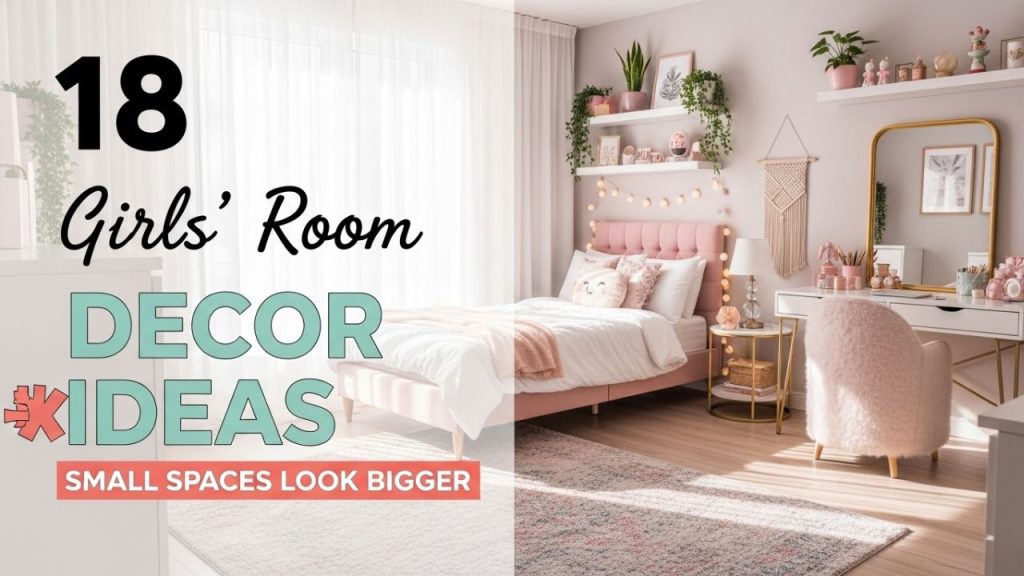Small rooms can still have big style. When decorating a girl’s room with limited square footage, every design choice matters.
Whether it’s a teen retreat, a cozy tween nook, or a feminine adult space — the key is balancing personality with space-maximizing tricks.
Below are 18 smart decor ideas designed to make small girls’ rooms feel larger, brighter, and more beautiful — without sacrificing charm or function.

Table of Contents
1. Stick to a Light Color Palette
Why it works:
Light colors reflect more light, making a room feel open and airy.
How to do it:
- Use whites, soft pastels, or muted tones for walls, bedding, and curtains.
- Add a splash of color through small accessories like cushions or wall art.
What not to do:
- Avoid dark or saturated wall colors unless balanced with ample natural light.
- Don’t mix too many colors — it can make the room feel cluttered.
2. Use Vertical Storage Solutions
Why it works:
Using vertical space draws the eye upward, creating the illusion of height.
How to do it:
- Install floating shelves, hanging organizers, or tall bookcases.
- Hang hooks and pegboards for accessories and bags.
What not to do:
- Don’t let vertical storage dominate the room’s visual balance.
- Avoid overloading shelves — it can feel heavy and overwhelming.
3. Incorporate Mirrors Strategically
Why it works:
Mirrors bounce light and reflect space, making any room feel larger.
How to do it:
- Place a large mirror opposite a window or light source.
- Try mirrored furniture like nightstands or wardrobe doors.
What not to do:
- Avoid placing mirrors where they reflect clutter or dark corners.
- Don’t crowd the wall with multiple small mirrors — it reduces impact.
Also Read: 31 Blue Home Decor Ideas for a Royal Touch
4. Choose Furniture with Exposed Legs
Why it works:
Leggy furniture makes the floor more visible, helping the space breathe.
How to do it:
- Opt for a raised bed, chair, or desk rather than boxy designs.
- Mid-century modern styles work especially well.
What not to do:
- Don’t place bulky furniture directly on the floor — it visually compresses the space.
5. Make Use of Under-Bed Storage
Why it works:
It hides clutter while freeing up floor space.
How to do it:
- Use rolling bins, storage drawers, or even a bed with built-in drawers.
- Store items like seasonal clothes, toys, or school supplies.
What not to do:
- Don’t let the space turn into a dumping ground — use labeled storage.
6. Limit Patterns to One Feature
Why it works:
Too many patterns can visually shrink a space, but one focal pattern adds style without crowding.
How to do it:
- Use a bold pattern on the bedspread, an accent wall, or a rug.
- Keep the rest of the decor solid or minimal.
What not to do:
- Avoid mixing multiple patterns of varying scale.
- Don’t use dark patterns on all walls.
7. Use Multipurpose Furniture
Why it works:
Functional furniture cuts clutter and saves space.
How to do it:
- Try a daybed with storage, a vanity desk, or ottomans that double as seating and storage.
- Foldable or nesting furniture is great for tight spaces.
What not to do:
- Don’t overcomplicate with too many fold-out mechanisms — simplicity wins in small rooms.
8. Go for Floor-Length Curtains
Why it works:
Long curtains add height and elegance, making the ceilings feel taller.
How to do it:
- Hang curtains from just below the ceiling, even if the window is small.
- Use light, sheer fabrics to maintain openness.
What not to do:
- Avoid heavy, dark drapes that block natural light.
- Don’t hang curtains at window height — it cuts the vertical line.
9. Keep the Floor as Clear as Possible
Why it works:
A visible floor creates the illusion of more space.
How to do it:
- Mount lighting and shelves on walls.
- Use wall hooks for bags and accessories.
What not to do:
- Don’t leave baskets, laundry, or furniture legs scattered across the floor.
10. Install a Floating Desk or Vanity
Why it works:
Wall-mounted desks free up floor space and look streamlined.
How to do it:
- Choose a minimal floating design with a drawer for essentials.
- Add a small stool or foldable chair beneath.
What not to do:
- Don’t choose oversized or elaborate desk units.
11. Add Clear or Acrylic Furniture Pieces
Why it works:
Transparent furniture takes up less visual space.
How to do it:
- Use a clear acrylic chair, side table, or storage box.
- Combine with light-colored decor for an airy look.
What not to do:
- Avoid using clear items in rooms with too much clutter — they’ll only reveal more mess.
12. Use a Large Statement Rug
Why it works:
A single large rug anchors the space and makes it feel cohesive and spacious.
How to do it:
- Choose a light-toned or simple patterned rug.
- Make sure it extends under key furniture pieces like the bed and desk.
What not to do:
- Don’t use several small rugs — it divides the space visually.
13. Embrace Wall-Mounted Lighting
Why it works:
It eliminates the need for bulky lamps and frees up surfaces.
How to do it:
- Install sconces or swing-arm lights next to the bed or desk.
- Choose adjustable options for reading or task lighting.
What not to do:
- Don’t hang lights too low or too close to cluttered walls.
14. Create Zones with Visual Cues
Why it works:
Defining different “areas” helps a small space feel structured and intentional.
How to do it:
- Use rugs, lighting, or paint to mark zones for sleep, study, or reading.
- Arrange furniture around each function.
What not to do:
- Avoid blocking pathways or creating tight corners with zone dividers.
15. Paint the Ceiling a Lighter Color
Why it works:
A light ceiling opens up the room and draws the eyes upward.
How to do it:
- Use white or a pastel tint a shade lighter than your walls.
- Consider a subtle sheen to reflect more light.
What not to do:
- Don’t use dark or heavy paint on the ceiling in a small room.
16. Keep Decor Minimal but Meaningful
Why it works:
Too many decorative items can overwhelm; curated pieces make a statement.
How to do it:
- Display a few favorite items, like framed art, photos, or a vision board.
- Rotate decor seasonally to keep it fresh.
What not to do:
- Avoid filling every shelf and wall — leave some breathing room.
17. Use Wall Decals Instead of Artwork Clusters
Why it works:
Wall decals add personality without the bulk of framed art.
How to do it:
- Choose modern, peel-and-stick decals — floral, quotes, stars, or abstract shapes.
- Apply to one feature wall or corner.
What not to do:
- Don’t crowd all walls with different decals — choose one area and keep it simple.
18. Let in Natural Light (and Maximize It)
Why it works:
Natural light is the best space-expander — rooms feel larger and more inviting.
How to do it:
- Use sheer curtains, light blinds, or nothing at all if privacy allows.
- Clean windows often and avoid blocking them with furniture.
What not to do:
- Don’t hang heavy items in front of windows or use dark-tinted curtains.
Final Tip:
Creating the illusion of space is all about balance — not just between function and style, but also between what’s seen and unseen.
A small room with intentional choices and personal touches can feel bigger than a large one without them.
Let your girl’s room be both a retreat and a reflection of her personality — just with a little more room to breathe.








